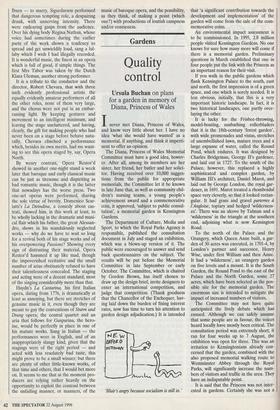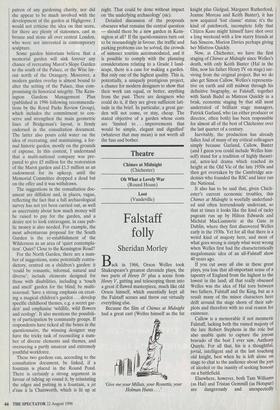Gardens
Quality control
Ursula Buchan on plans for a garden in memory of Diana, Princess of Wales
Inever met Diana, Princess of Wales, and know very little about her. I have no idea 'what she would have wanted' as a memorial, if anything, and think it imperti- nent to offer an opinion.
The Diana, Princess of Wales Memorial Committee must have a good idea, howev- er. After all, among its members are her sister, her friend, her butler and her solici- tor. Having received over 10,000 sugges- tions from the public for appropriate memorials, the Committee let it be known in late June that, as well as community chil- dren's nursing teams, a young people's achievement award and a commemorative coin, it approved, 'subject to public consul- tation', a memorial garden in Kensington Gardens.
The Department of Culture, Media and Sport, to which the Royal Parks Agency is responsible, published the consultation document in July and staged an exhibition, which was a blown-up version of it. The public were encouraged to answer and send back questionnaires on the subject. The results will be put before the Memorial Committee in late September or early October. The Committee, which is chaired by Gordon Brown, has itself chosen to draw up the design brief, invite designers to enter an international competition, and judge that competition. (Thank goodness that the Chancellor of the Exchequer, hav- ing laid down the burden of fixing interest rates, now has time to turn his attention to garden design adjudication.) It is intended Blair's angry because socialism is still in.' that 'a significant contribution towards the development and implementation' of the garden will come from the sale of the com- memorative coins.
An environmental impact assessment is to be commissioned. In 1995, 2.8 million people visited Kensington Gardens. No one knows for sure how many more will come if there is a memorial garden. Preliminary questions in March established that one in four people put the link with the Princess as an important reason for their visit.
If you walk in the public gardens which flank Kensington Palace to the south, east and north, the first impression is of a green space, and one which is sorely needed. It is less obvious, initially, that this is a very important historic landscape. In fact, it is two historical landscapes, one partly over- laying the other.
It is lucky for the Frisbee-throwing, model-boating, sunbathing rollerbladers that it is the 18th-century 'forest garden', with wide promenades and vistas, stretches of unembellished lawn, mature trees and a large expanse of water, called the Round Pond, which endures. It was designed by Charles Bridgeman, George II's gardener, and laid out in 1727. To the south of the Palace, however, this replaced a highly sophisticated and complex garden, by William III's architect, Daniel Marot, and laid out by George London, the royal gar- dener, in 1691. Marot treated a rhomboidal space very cleverly, so that it looked rectan- gular. It had grass and gravel parterres a l'Angloise, topiary and hedged 'wilderness- es'. There was an alcove by Taman and a `wilderness' in the triangle at the southern end, adjoining what is now Kensington Road.
To the north of the Palace and the Orangery, which Queen Anne built, a gar- den of 30 acres was executed, in 1701-4, by London's partner and successor, Henry Wise, under first William and then Anne. It had a 'wilderness', an orangery garden on five levels and a mount. It is the South Garden, the Round Pond to the east of the Palace and the North Garden, some 27 acres, which have been selected as the pos- sible site for the memorial garden. The enormous size is intended to mitigate the impact of increased numbers of visitors.
The Committee may not have quite anticipated the lively debate which has ensued. Although we can safely assume that some people are in favour, the voices heard locally have mostly been critical. The consultation period was extremely short; it ran for four weeks up to 7 August, the exhibition was open for three. This was an irritation to Kensingtonians already con- cerned that the garden, combined with the also proposed memorial walking route to Westminster Abbey through the Royal Parks, will significantly increase the num- bers of visitors and traffic in the area. They have an indisputable point.
It is said that the Princess was not inter- ested in gardens. Certainly she was not a patron of any gardening charity, nor did she appear to be much involved with the development of the garden at Highgrove. I would not criticise the idea on that score, for there are plenty of statesmen, cast in bronze and stone all over central London, who were not interested in contemporary sculpture.
Some garden historians believe that a memorial garden will sink forever any chance of recreating Marot's Slope Garden to the south of the Palace, or the Wise lay- out north of the Orangery. Moreover, a modem garden overlay is almost bound to alter the setting of the Palace, thus com- promising its historical integrity. The Kens- ington Gardens Management Plan (published in 1996 following recommenda- tions by the Royal Parks Review Group), which includes the commitment to con- serve and strengthen the main geometric lines of Bridgeman's layout, is firmly endorsed in the consultation document. The latter also pours cold water on the idea of recreating, and maintaining, a for- mal historic garden, mostly on the grounds of expense. In this context, I understand that a multi-national company was pre- pared to give £5 million for the restoration of the Marot garden and £1.5 million as an endowment for its upkeep, until the Memorial Committee dropped a dead bat on the offer and it was withdrawn.
The suggestions in the consultation doc- ument are diffident and, in places, vague, reflecting the fact that a full archaeological survey has not yet been carried out, as well as uncertainty about how much money will be raised to pay for the garden, and a desire not to look extravagant, in case pub- lic money is also needed. For example, the most adventurous proposal for the South Garden is the re-establishment of the Wilderness as an area of 'quiet contempla- tion'. Quiet? Close to the Kensington Road?
For the North Garden, there are a num- ber of suggestions, some potentially contra- dictory, centred on a children's garden: it `could be romantic, informal, natural and diverse'; include elements designed for those with disabilities, including a 'touch and smell' garden for the blind; be multi- seasonal; 'have a strong emphasis on creat- ing a magical children's garden . .. develop specific childhood themes, e.g. a secret gar- den' and emphasise 'wildlife, wild flowers and ecology'. It also mentions the possibili- ty of participation by community groups. If respondents have ticked all the boxes in the questionnaire, the winning designer may have the tricky task of reconciling a num- ber of diverse elements and themes, and overseeing a partly amateur and extremely youthful workforce.
These two gardens can, according to the consultation document, be linked, if a fountain is placed in the Round Pond. There is certainly a strong argument in favour of tidying up round it, by reinstating the edges and putting in a fountain, a jet d'eau a la Chatsworth, which is lit up at night. That could be done without impact on 'the underlying archaeology' (sic).
Detailed discussion of the proposals obscures what remains the central question — should there be a new garden in Kens- ington at all? If the questionnaires turn out to be resoundingly in favour, the traffic and parking problems can be solved, the crowds of summer tourists accommodated, and it is possible to comply with the planning considerations relating to a Grade I land- scape, there is a case for making a garden. But only one of the highest quality. This is, potentially, a uniquely prestigious project, a chance for modem designers to show that their work can equal, or better, anything from the past. There are designers who could do it, if they are given sufficient lati- tude in the brief. In particular, a great gar- den will not come, or stay, cheap. The stated objective of a garden whose costs are 'limited to . . . improvements that would be simple, elegant and dignified' (whatever that may mean) is not worth all the fuss and bother.

























































 Previous page
Previous page